BMC’s lightweight Teammachine race bike has evolved once again for its tenth anniversary, with the 2021 design promising lowering weight, increased stiffness and improved aerodynamics.
The Teammachine is BMC’s most successful road bike and, as a lightweight race machine, it’s seen plenty of success, having been ridden to victory at Grand Tours and the World Championships.
For 2021, the Swiss brand is following one of this year’s trends by making aerodynamic improvements to its lightweight all-rounder, plus adding more integration and a handful of very clever design solutions.
The flagship SLR 01 frame comes in at a claimed 820g for a 54cm frame (in the lightest finish, with hardware), shaving weight off the fork (claimed weight 345g). BMC says the 2021 Teammachine SLR 01 ‘system weight’ has dropped from 1,815g on the previous model to 1,655g here.
There’s also a new second-tier frame, the SLR Carbon, which shares the same frame features as the flagship frame, but increases the claimed frame and fork weighs to 990g and 375g respectively.
All in all, the 2021 Teammachine range includes 12 bikes priced from £2,700 to £10,250.
Six things you should know about the new BMC Teammachine
- BMC claims the new Teammachine SLR 01 is 6 per cent faster, 9 per cent lighter and 20 per cent stiffer
- Two disc-only frames: Teammachine SLR 01 (claimed weight 820g) and SLR (claimed weight 990g)
- The SLR 01 is BMC’s most integrated design yet, with a new dedicated cockpit and seatpost (and even Teammachine-specific bottle cages)
- Details such as stealth dropouts help make this the most aerodynamic SLR ever, according to BMC
- BMC has built a new super-computer to design it
- The 12 model line-up starts at £2,700 and ends at £10,250
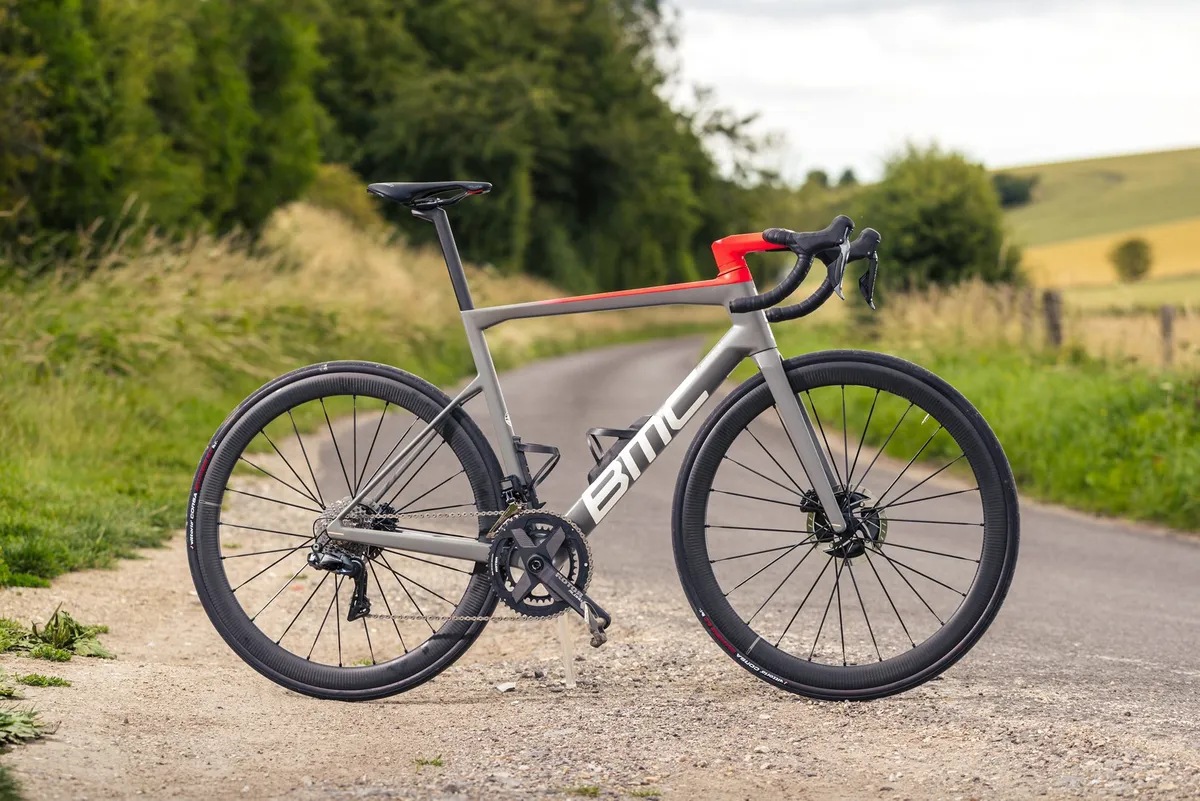
The 2021 Teammachine comes with some fairly bold claims from BMC but, at first glance, the new bike doesn’t look wildly different to the current Teammachine, with key areas such as the seatstays and top tube bearing a strong resemblance to the previous bike.
But then the last generation Teammachine did establish many of the design cues we’ve come to take for granted on the latest bikes, including dropped seatstays and aero considerations in the fork interface.
Both have become part of redesigns of the Teammachine's rivals, such as the new Trek Emonda or Cannondale’s latest SuperSix Evo, our Bike of the Year for 2020.
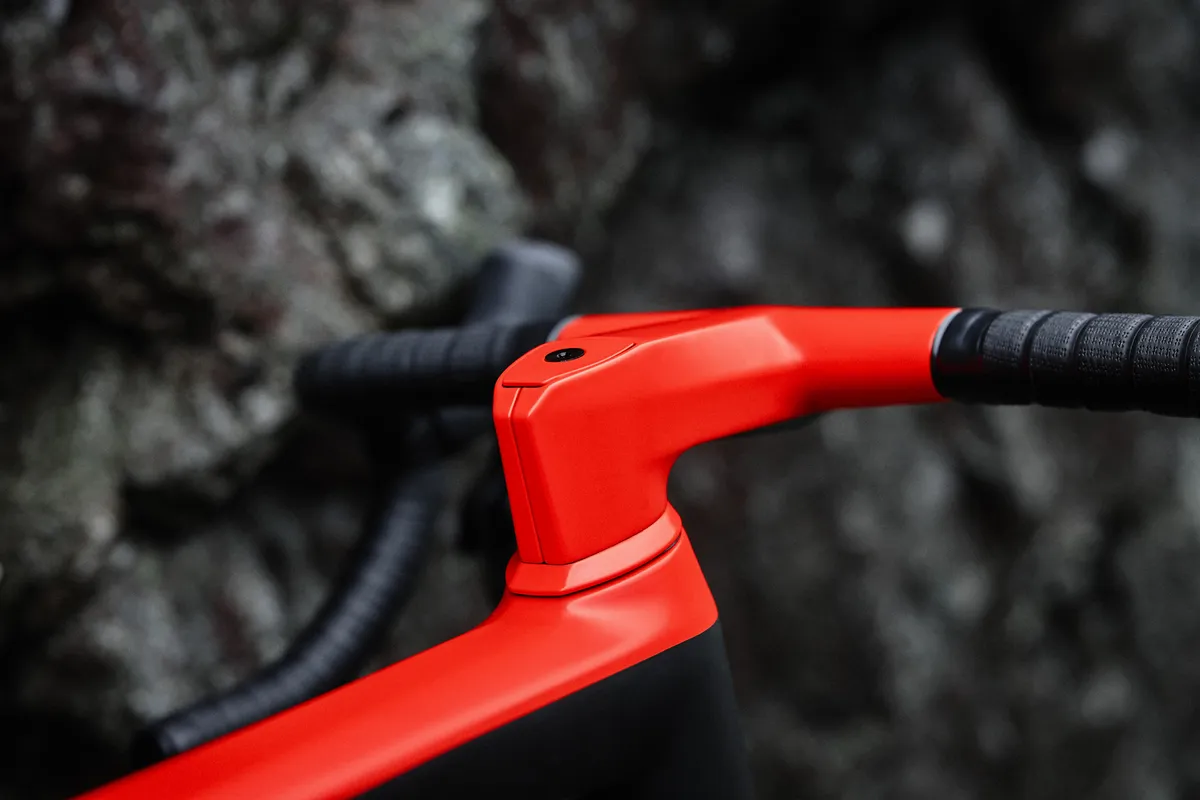
However, BMC tells us every surface on the new bike has changed. That is most noticeable in the shaping of the down tube, inspired by last year’s Roadmachine and now with a bigger bottom bracket (BB) contact area.
The integrated bottle cage design, previously seen on the Timemachine aero bike (dubbed Aerocore), has also been refined to maximise low weight here, too, while the fork has flatter blades, truncated at the back, and a stealth dropout design to improve aerodynamics.
“With the new Teammachine, we have created a unique and perfect balance of weight, stiffness and compliance, and enhanced it with advanced aerodynamics which will surpass the expectations of the most demanding riders,” said Mart Otten, senior product manager at BMC. “This is the flagship of BMC’s ambitions for the next decade.”
So what’s changed?
When BMC designed the previous, third-generation Teammachine, the brand introduced a super-computer-based design tool called ACE (Accelerated Composite Evolution) as a way of optimising construction in the frame and fork. The result, according to BMC’s design team, was to achieve a balance of stiffness, weight and compliance.
With this new bike, BMC has taken the original analysis tool and upped the super-computer power and reach to create ACE+. This has allowed BMC to create virtual prototypes much faster, identify the best combinations of tube shapes and carbon layup, and, perhaps most significantly, analyse the aerodynamics of a design using Computational Fluid Dynamics (CFD).
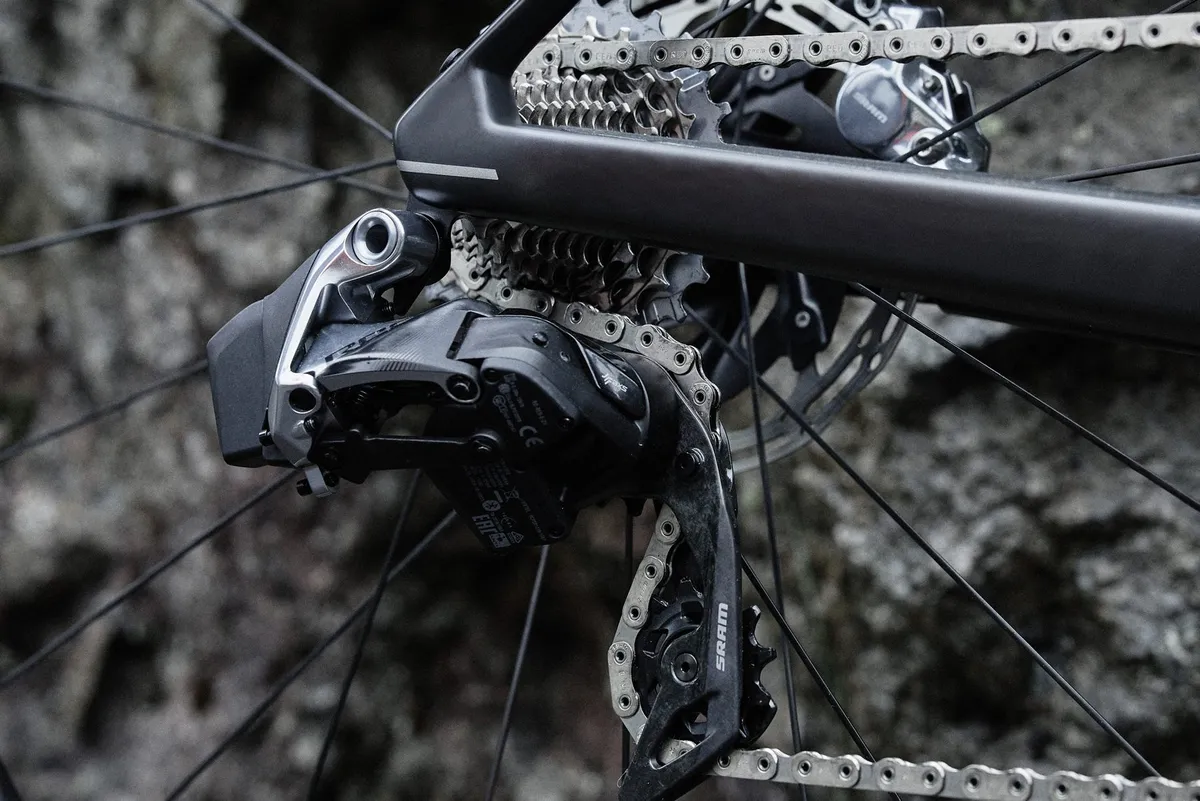
Almost any new bike launch is accompanied by claims of how the latest design is stiffer, lighter and faster, but some of the smaller details and refinements to the SLR01 are particularly interesting.
First there’s the new minimalist flat mounts for the disc brake calipers. BMC has increased the bolt spacing on the fork brake mounts to offer more adjustment and a more secure design, the result of feedback from BMC’s pro team mechanics last season.
The eagled-eyed among you may have noticed the new ‘stealth’ dropouts on the thru-axles. Instead of a standard two-piece design, BMC has instead in-moulded a captive nut into the frame itself. This design translates to fewer parts, less weight and, BMC would argue, a better-looking chassis too.
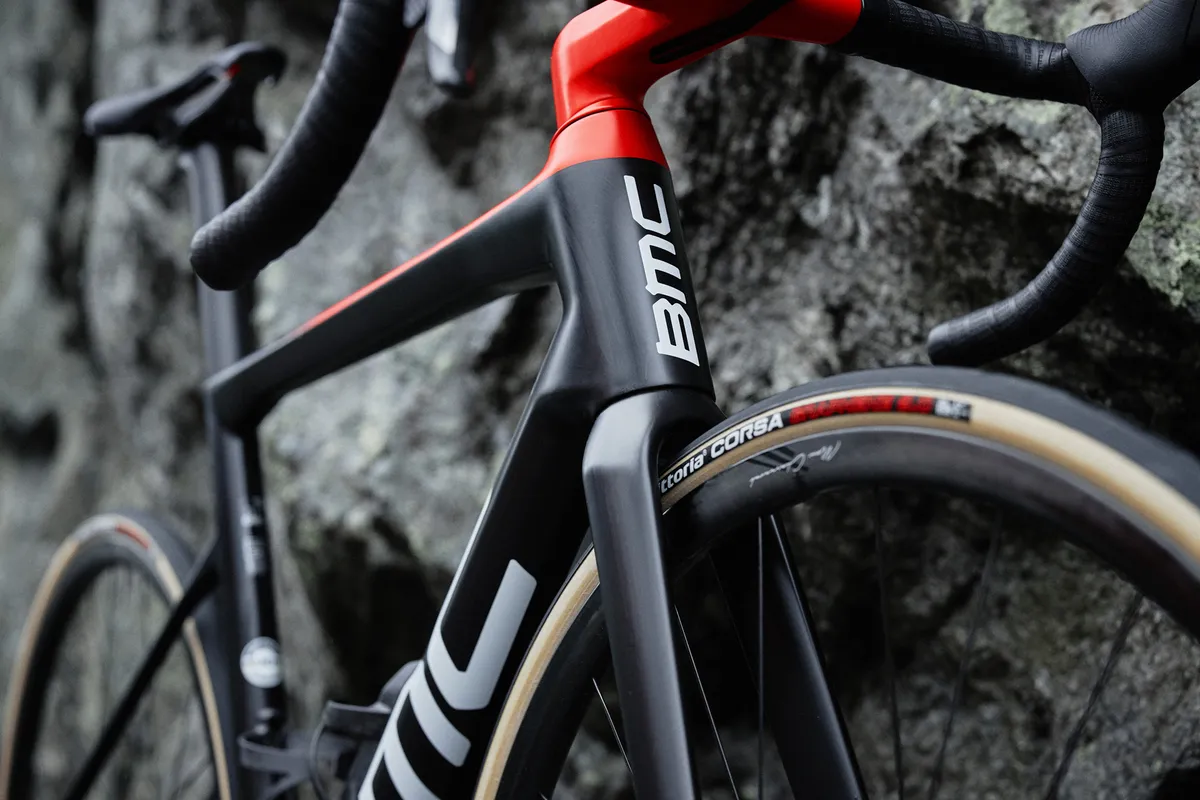
Tyre clearance is another detail that has been addressed with the new bike and the Teammachine can now accept 30mm (measured tyre width).
The seatpost clamp has shrunk, meanwhile, and its position dropped by between 10 and 15mm depending on size, so the frame is subtly more sloping than before.
Ten years of the Teammachine
It's ten years since BMC's first Teammachine was launched and, in the Swiss brand's short history (BMC was only founded in 1994), the flagship road bike has had more than its fair share of success.
2011 – The Teammachine wins the Tour de France on its first outing beneath Cadel Evans, who is still a brand ambassador for BMC and one of the test pilots for the 2021 bike
2012 – A year later, Phillipe Gilbert wins the World Championships on the Teammachine
2016 – Greg Van Avermaet takes the Olympic road race title on the second-generation SLR, launched in 2014 and the first bike to use BMC’s ACE design software
2017 – The third-generation SLR launches with BMC’s ICS integrated cockpit components and a disc brake option
Stiffness where it’s needed
With the updated design, BMC aimed to improve stiffness but only where needed, and that meant taking the bottom bracket and down tube back to the drawing board.
The latest BB shell has a much wider contact area with the reshaped down tube, creating a more fluid design that is claimed to offer significant improvements in torsional stiffness.
Up front, the interface between the cockpit, steerer and head tube has been refined in a bid to improve the handling. Within the integrated cockpit, BMC has combined a fairly traditional tapered 1-1/8in to 1.5in headset arrangement with the definitively non-traditional rectangular steerer tube first seen on the 2020 Roadmachine.
In BMC’s testing, it claims the new bike is 20 per cent stiffer laterally in the rear triangle. Overall, there is a slight increase of around 4 per cent in torsional stiffness, which is claimed to improve handling, which is matched with a very small 2 per cent increase in vertical compliance.
Weighty matters
It seems that with this new Teammachine coming hot on the heels of Cannondale’s SuperSix Evo, Giant's new flyweight TCR and Trek’s light and aero Emonda SLR we’re in the midst of a lightweight aero race, so let’s talk numbers.
BMC claims the SLR 01 frame weighs in at 820g (54cm in its lightest finish, with hardware) – that’s actually 5g more than the previous frame. The fork, however, now comes in at a claimed 345g – lighter than the previous incarnation by 50g – while the dedicated seatpost is now 185g (a 10g saving).
All that makes for a very light chassis, though perhaps not quite as headline grabbing as the Trek Emonda’s claimed 698g (however, that’s for an unpainted 56cm with no hardware) Regardless, the Teammachine is still one very light chassis.
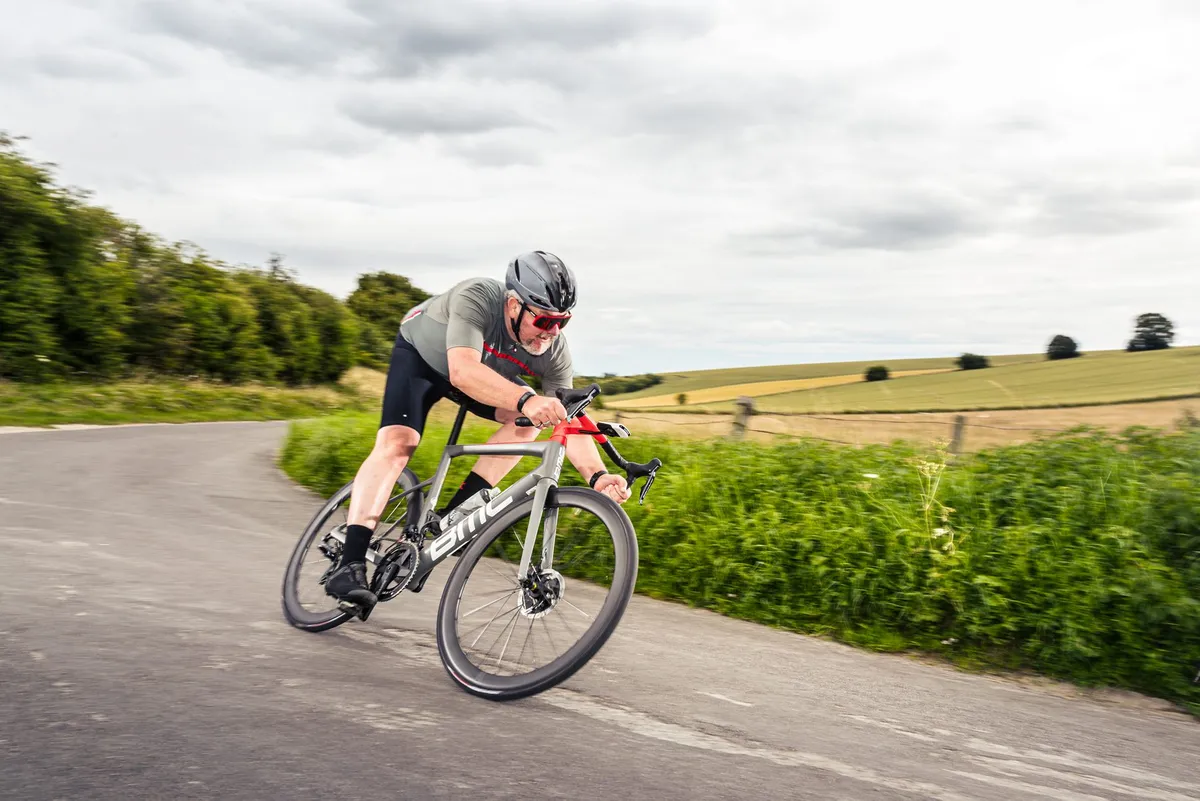
When you factor in the new one-piece ICS cockpit at just 320g, you can see that weight reduction goes much further than the frame alone.
BMC claims this is 30 per cent lighter than a top-end traditional, two-piece set-up and 105g lighter than the original ICS system. That’s not taking into account the superior aerodynamics – aero is usually the enemy of lightweight.
Improvements in aerodynamic performance usually mean more weight, but BMC has looked to shave weight wherever possible, down to using a lighter paint for the finish. All in all, the Teammachine SLR01’s system weight has dropped from 1,815g on the previous model to 1,655g here.
The result is a complete bike weight that’s a claimed 9 per cent lighter than the previous Teammachine Disc, with a claimed weight on the 54cm SLR01 One of 6.5kg/14.33lb, including two Aerocore bottle cages (we’ll come on to those soon). Our 56cm test bike with cages in place tips the scales at 7.09kg.
Aero advancements
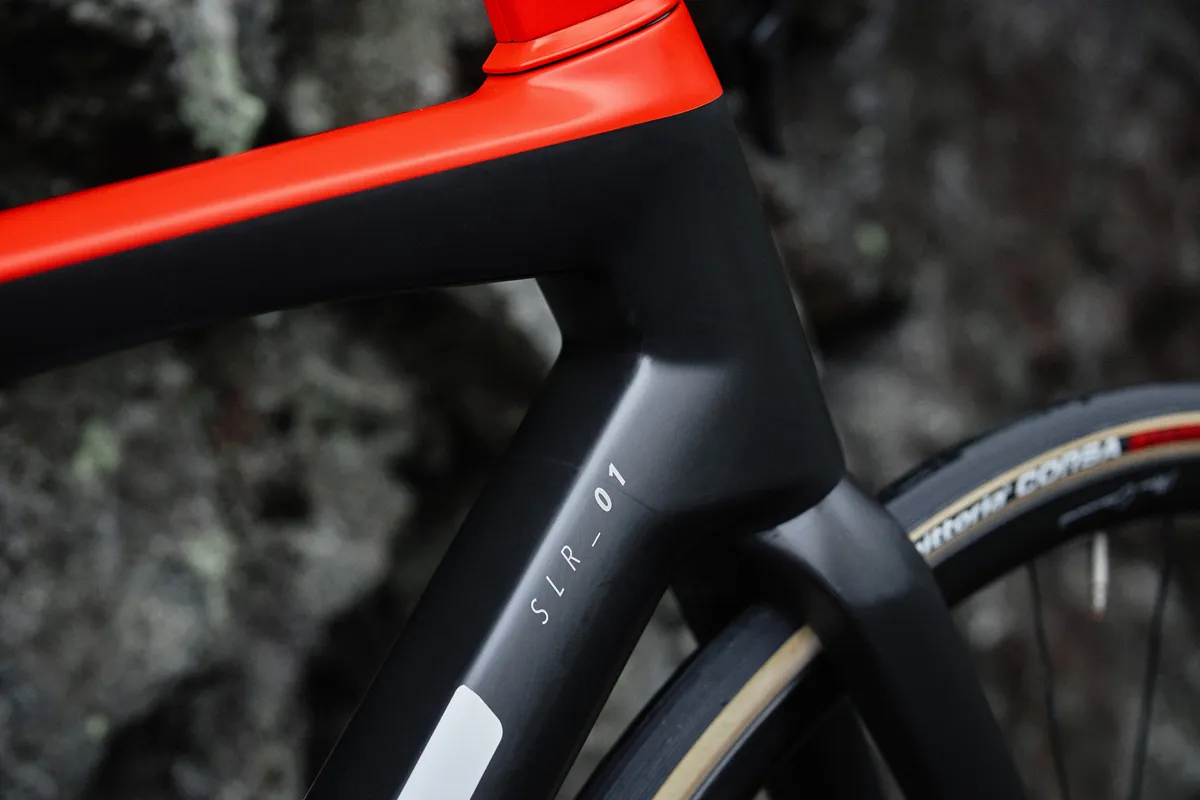
Changes to the Teammachine may appear subtle from the outside but the frame’s updated tube shapes have a significant impact on aerodynamic performance and have been made possible by BMC’s updated super-computer, according to Stefan Christ, the company’s head of development.
“If you look at the head tube on the new bike you’ll see it has the same width dimension as the current bike,” says Christ.
“That’s because we have very strict measures on head tube stiffness we have to maintain – it has to be this wide to handle those loads – but the ACE+ optimisation tools led to the back being stretched out and the front profile becoming much more round than before.
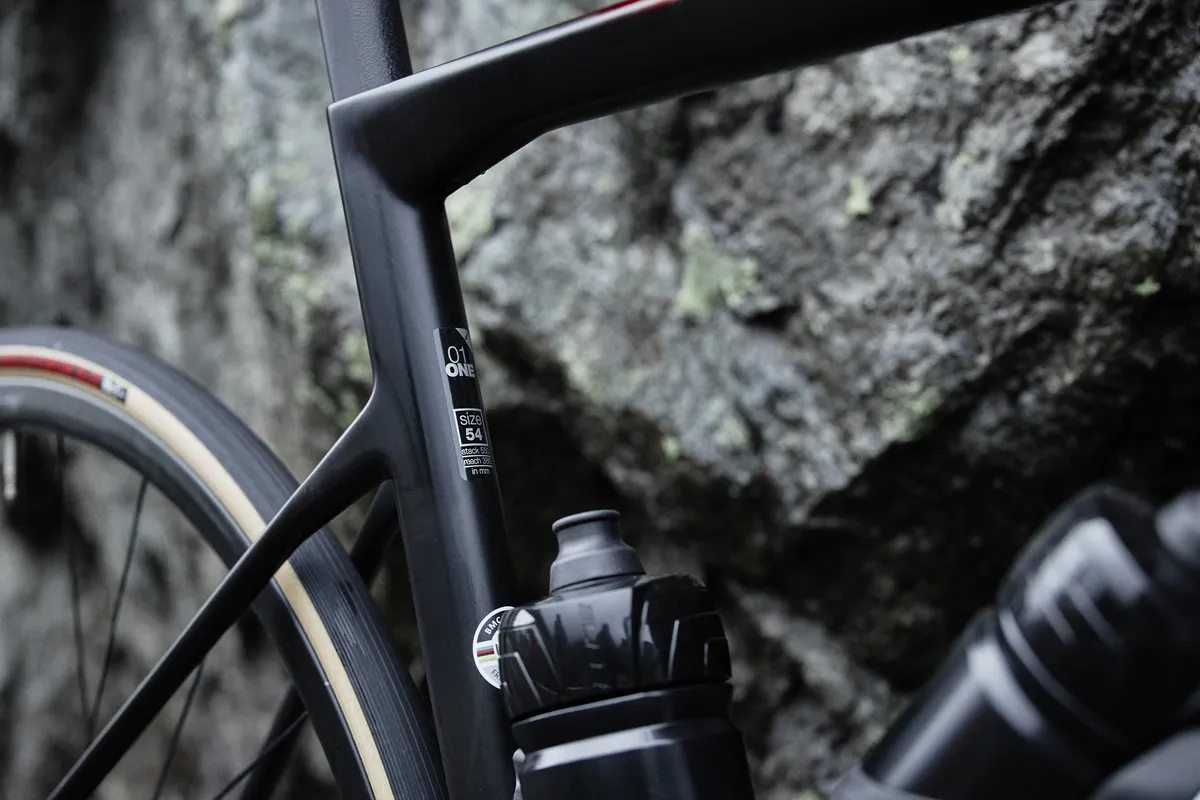
The fork has changed, too, as Christ explains. “The current bike has very large profiles on the legs to achieve our torsional stiffness goals,” he says. “With the ACE+ optimisation, the fork leg profile became much more of a truncated aerodynamic shape, with a curve to the leading edge and a chopped back, though not as extreme as those found on the Timemachine.
“We have used new carbon materials that combine high stiffness and strength, so we’ve got a fork that’s the same stiffness and strength [as the previous model] and yet 50g lighter and significantly more aerodynamic.”
Aero at its core
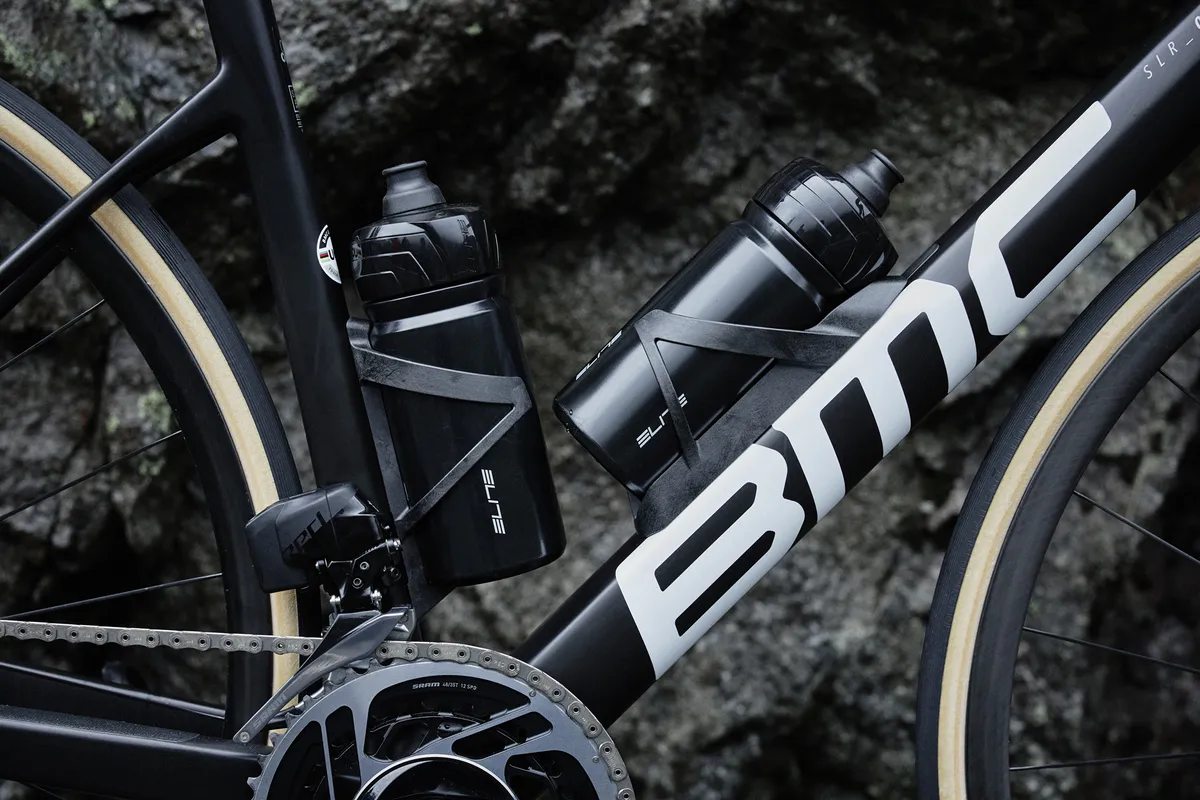
BMC’s Aerocore design principle aims to integrate elements you’d add to a bike (in this case bottle cages) and use them to improve aerodynamics, not hamper. It’s something BMC introduced with the Timemachine, but here it’s optimised for both low weight and aerodynamics.
The new bottle cages (included with the bike) have a flush-fitting base and were designed to integrate with the down tube. This eliminates turbulent air (and drag) being created from the gap between cage and bottle, according to BMC, and the truncated airfoil shape of the down tube is optimised to work with the cage (and to work with standard bottles, not a dedicated aero bottle design).
It’s simple but pretty clever stuff and, if you really don’t like BMC’s bottle cages for any reason, you can fit standard cages in their place (though we're not sure why you would).
The Aerocage’s are carbon and BMC claims they are among the lightest available. BMC also claims they have been tested on the cobbles by Classics legend and BMC ambassador Fabian Cancellara, to ensure bottles remain secure in tough conditions.
ICS goes up a notch
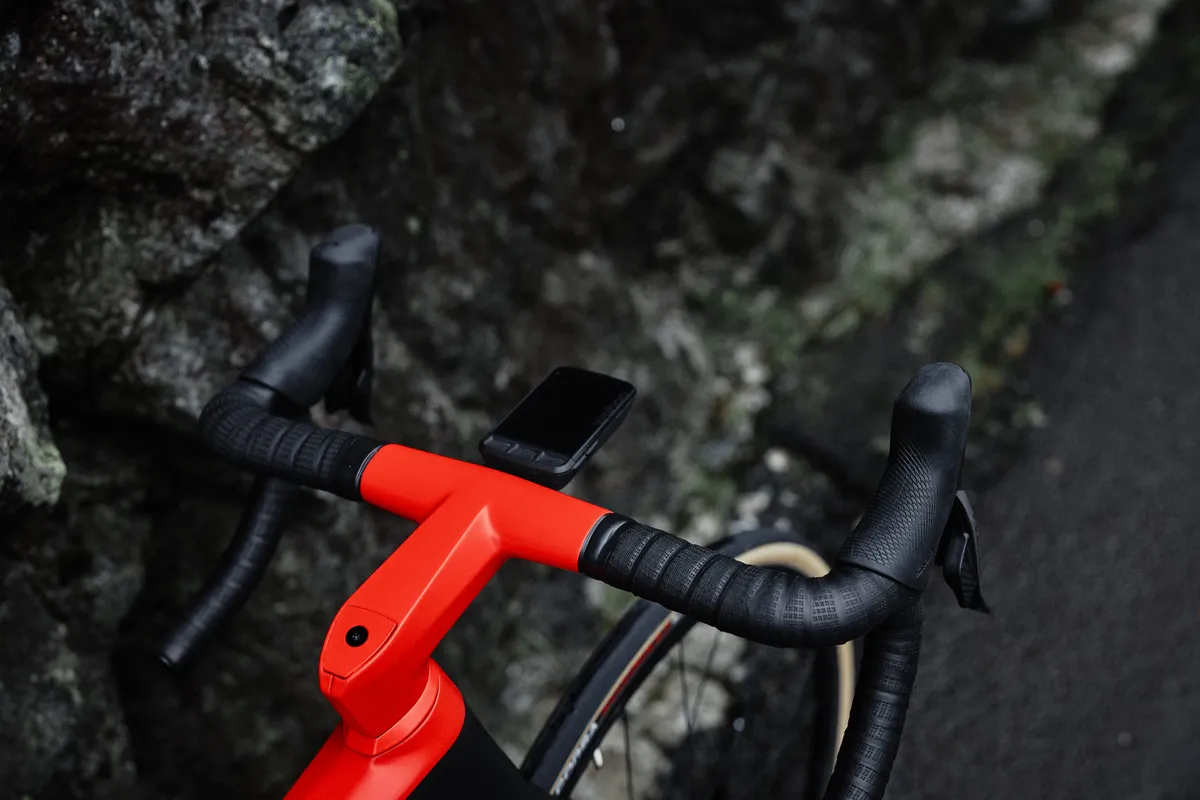
BMC’s ICS (Integrated Cable System) cockpit was first introduced in 2016 and the Swiss company was one of the first brand’s to bring this level of integration into a standard road race bike (rather than a time trial bike).
Now ICS has been revamped for the new SLR 01. The idea behind the design is to offer the clean lines and aerodynamic advantage of full integration, but without the problems associated with complex hidden cable designs.
Visually the new ICS carbon looks very clean and should, in theory, equate to very little drag. All of the hardware in the clamping mechanism is replaceable (a smart touch just in case you're ham-fisted enough to damage a bolt) and it works in much the same way as a standard stem clamp, so it shouldn’t hold any fear for maintenance or packing the bike away for a trip.
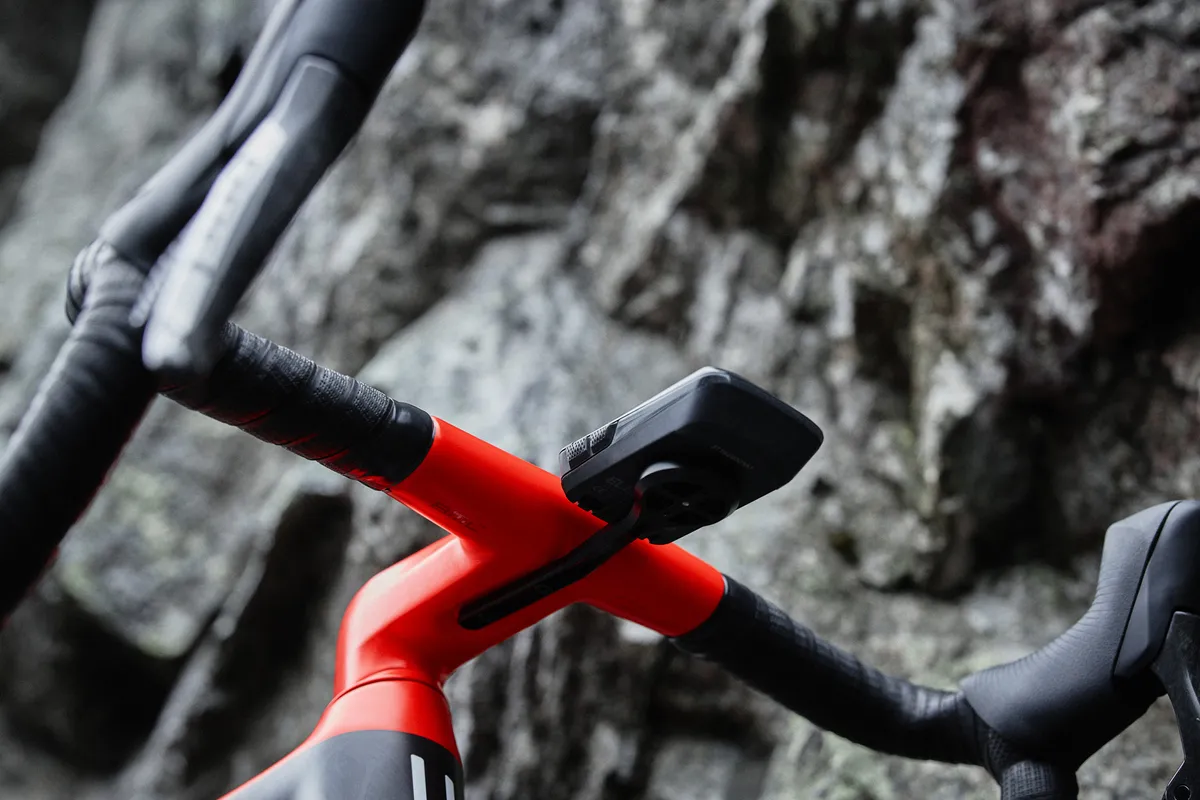
On more affordable models you get ICS2. Here, the stem is lighter by 15g than the original and features fully hidden bolts, for better aerodynamics, and a simple integrated cable route, via a replaceable two-piece channel that runs underneath the alloy part of the stem (it means you can alter stem length without having to un-cable your bike).
Both ICS and ICS2 come with Garmin and Wahoo alloy out-front computer mounts.
BMC says all of the Teammachine’s aerodynamic advancements were validated at the velodrome across the street from its HQ by NTT Pro Cycling team riders.
BMC used a selection of riders with different body proportions and testing was conducted at 45kph, with riders in the drops and all dressed in the same team kit, with identical components and wheels on each bike (the old and new bikes, that is).
On average, across all riders and all test runs, BMC's results showed a 6 per cent reduction in drag from the old Teammachine to the new one.
Are you sitting comfortably?
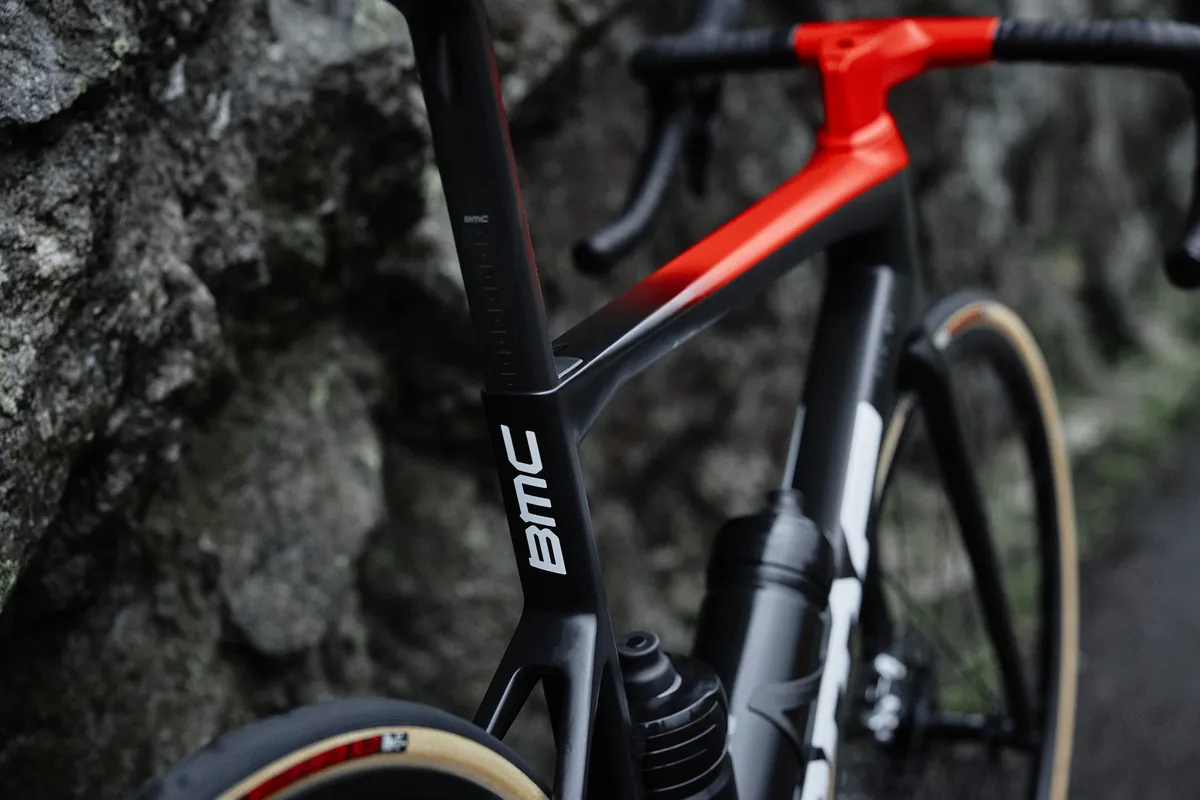
Now, on to comfort. BMC is a brand never shy of using acronyms such as ACE+ and ICS, but there’s yet another associated with the Teammachine and that’s TCC, or Tunes Compliance Concept.
It was something first rolled out way back when the original SLR 01 was launched a decade ago, with the key feature being its dropped seatstays – something that pretty much every other brand out there has since introduced.
BMC claims the 2021 Teammachine is the most comfortable yet, with the carbon layup being optimised to deliver compliance levels through vertical movement in the frame and seatpost flex. The new D-shaped seatpost has also been redesigned to remove any excess weight.
2021 BMC Teammachine range
The Teammachine range includes 12 bikes and goes from £2,700 for the BMC SLR Four with Shimano 105 to £10,250 for the SLR 01 One with SRAM Red AXS.
All SLR 01 bikes get the premium carbon frameset, whereas the SLR gets a more standard carbon frame.
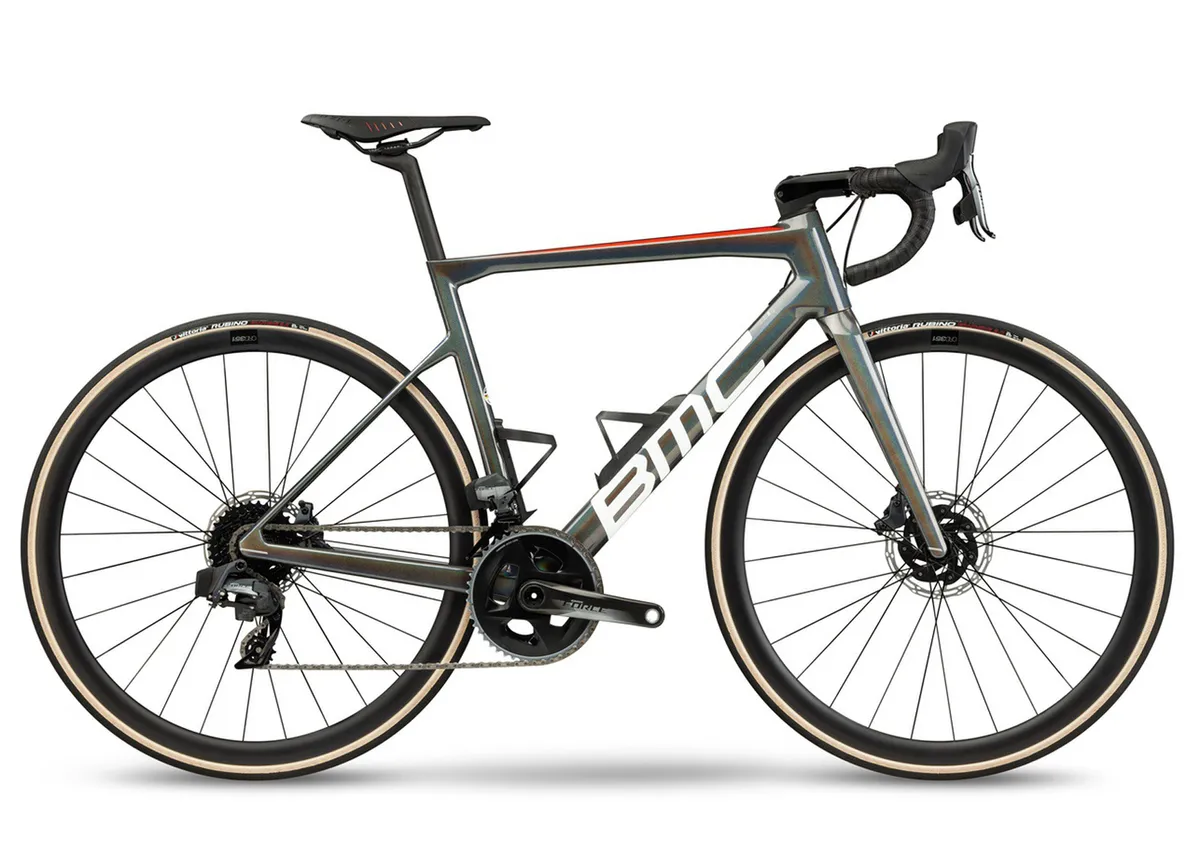
The two top-end bikes, the SLR 01 One and Two, get the latest ICS cockpit, while the SLR 01 Three and Four use a standard bar with BMC’s ICS2 stem.
Of the second-tier SLR bikes, the Teammachine SLR One uses an ICS2 and standard bar, while the rest use conventional bars and stems.
Finally, the new SLR is disc only, but BMC tells us that in some territories where rim brakes remain popular, the previous SLR in rim brake form will continue with a single model.
BMC Teammachine SLR 01 One
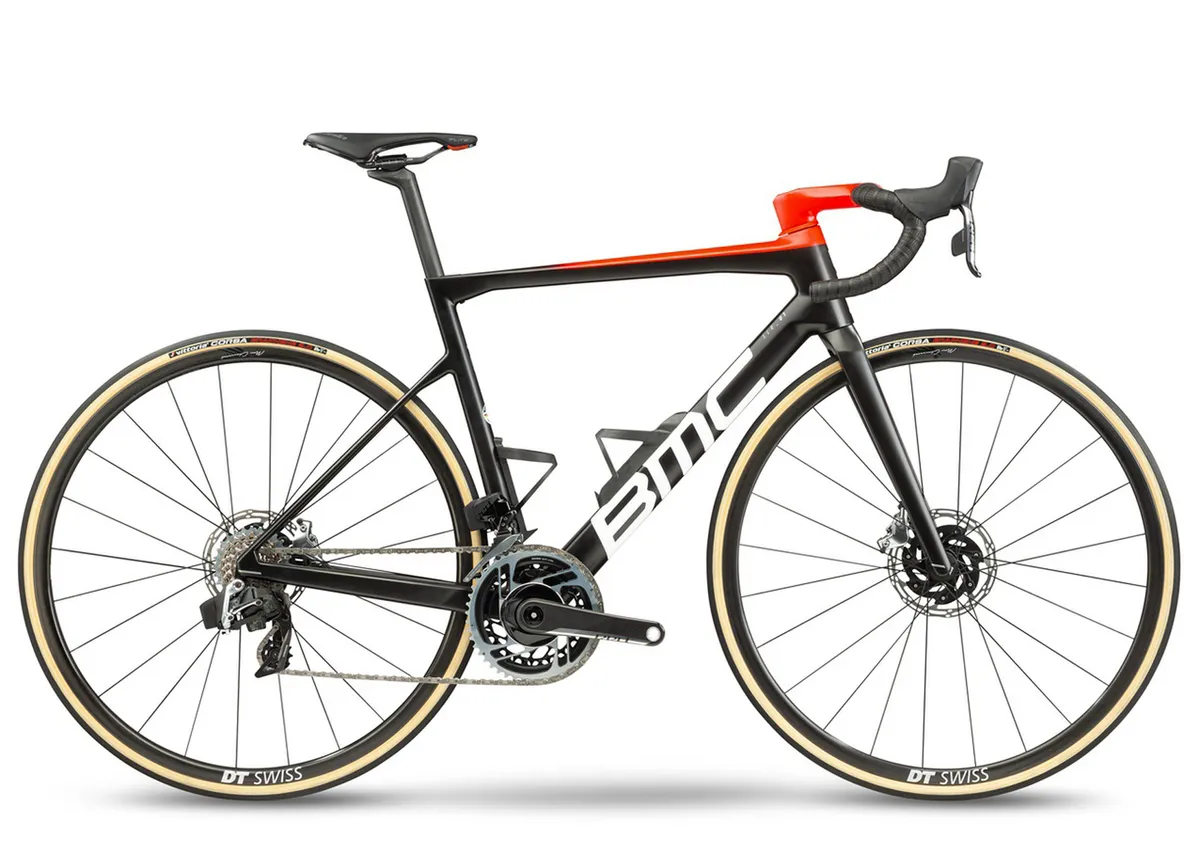
- Price: £10,250 / €11,499 / $10,999
- Weight: 6.5kg (54cm – claimed weight, including two bottle cages)
- Frame: Premium Carbon with stealth dropouts
- Fork: Premium Carbon with stealth dropouts
- Gears: SRAM Red AXS (48/35, 10-28)
- Brakes: SRAM Red
- Wheels: DT Swiss PRC 1100 DB Mon Chasseral
- Bar/stem: ICS bar/stem combo
- Saddle: Selle Italia Flite Boost
- Seatpost: Teammachine D-shaped carbon
- Tyres: Vittoria Corsa Graphene 2.0 25mm
- Extras: Out-front computer mount, two Aerocore bottle cages, tubeless valves, integrated computer mount
BMC Teammachine SLR 01 Two
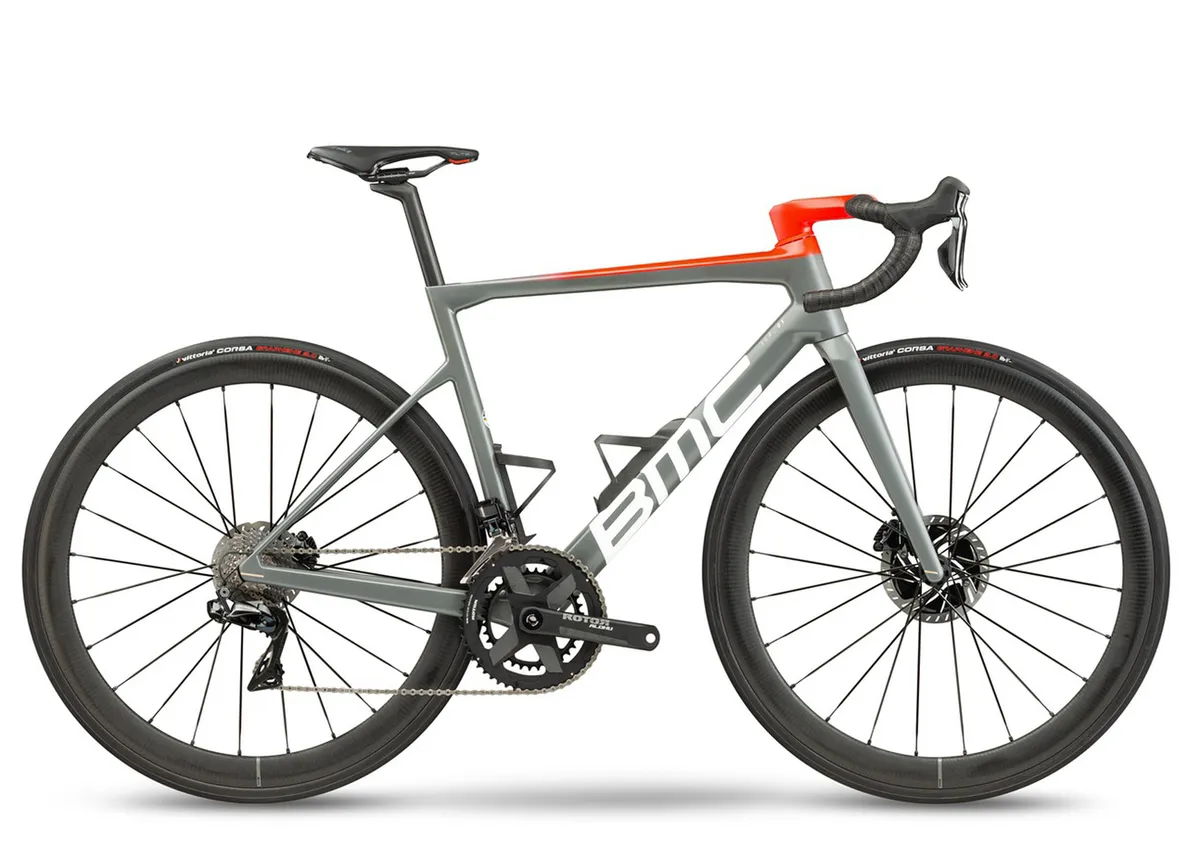
- Price: £9,800 / €10,499 / $10,999
- Weight: 7.09kg (actual weight 56cm, including two bottle cages)
- Frame: Premium Carbon with stealth dropouts
- Fork: Premium Carbon with stealth dropouts
- Gears: Shimano Dura-Ace Di2 (52/36, 11-30)
- Brakes: Shimano Dura-Ace hydraulic disc
- Wheels: Mavic Cosmic SLR 45
- Bar/stem: ICS bar/stem combo 42cm wide, 120mm equivalent stem length
- Saddle: Selle Italia Flite Boost
- Seatpost: Teammachine D-shaped carbon
- Tyres: Vittoria Corsa Graphene 2.0
- Extras: Out-front computer mount, 2 x Aerocore bottle cages, Rotor ADHLU 24 chainset, tubeless valves, integrated computer mount
BMC Teammachine SLR 01 Three
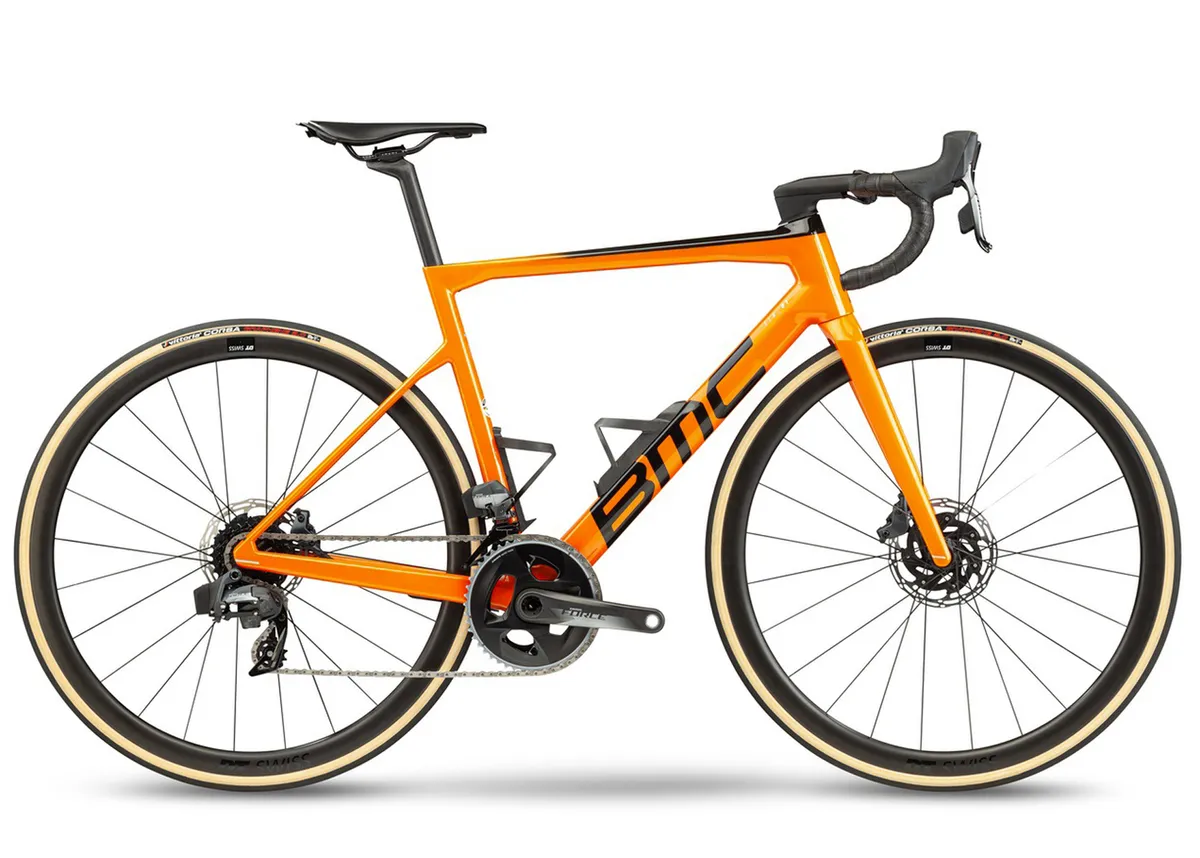
- Price: £6,950 / €7,799 / $7,499
- Weight: 7.4kg (54cm – claimed weight, including two bottle cages)
- Frame: Premium Carbon with stealth dropouts
- Fork: Premium Carbon with stealth dropouts
- Gears: SRAM Force AXS (48/35, 10-28)
- Brakes: SRAM Force
- Wheels: DT Swiss PRC 1650 DB Spline carbon
- Bar/stem: BMC RAB02 bar, ICS2 stem
- Saddle: Fizik Antares Versus Evo R5
- Seatpost: Teammachine D-shaped carbon
- Tyres: Vittoria Corsa 25mm
- Extras: Out-front computer mount, two Aerocore bottle cages, tubeless valves, integrated computer mount
BMC Teammachine SLR 01 Four
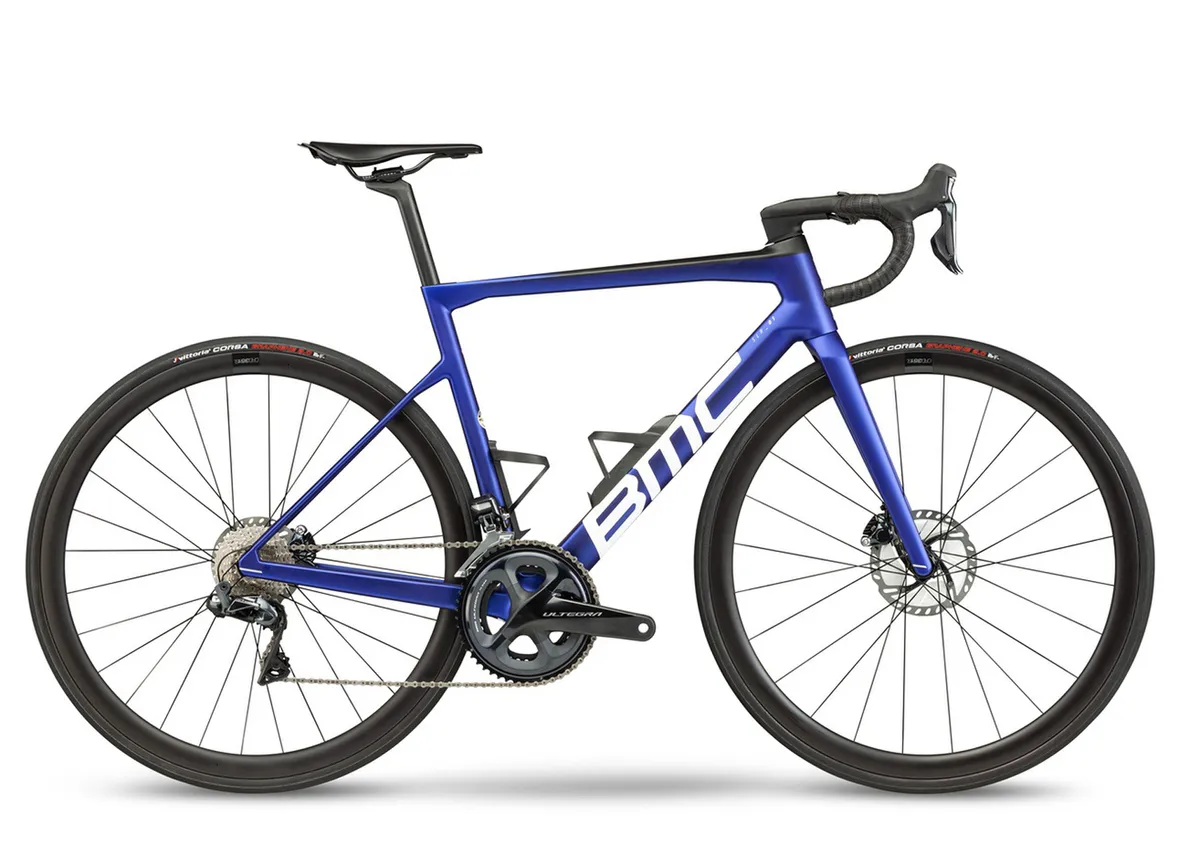
- Price: £6,500 / €7,299 / $6,999
- Weight: 7.2kg (54cm – claimed weight, including two bottle cages)
- Frame: Premium Carbon with stealth dropouts
- Fork: Premium Carbon with stealth dropouts
- Gears: Shimano Ultegra Di2 (52/36, 11-30)
- Brakes: Shimano Ultegra
- Wheels: CRD-351 SL Carbon tubeless ready
- Bar/stem: BMC RAB02 bar, ICS2 stem
- Saddle: Fizik Antares Versus Evo R5
- Seatpost: Teammachine D-shaped carbon
- Tyres: Vittoria Corsa 25mm
- Extras: Out-front computer mount, two Aerocore bottle cages, tubeless valves, integrated computer mount
BMC Teammachine SLR 01 module
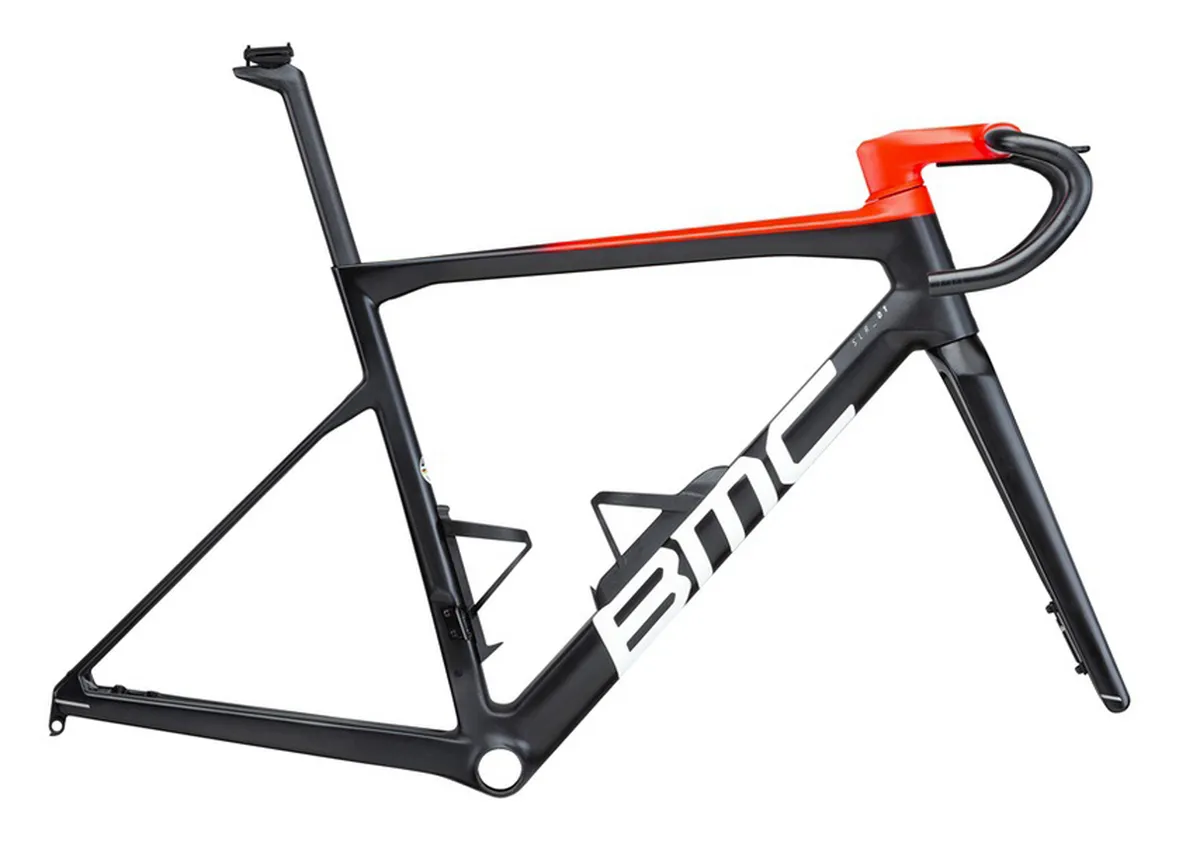
- Price: £3,999 / €4,799, /$4,699
- Includes: Frame, fork, ICS bar/stem, seatpost, two Aerocore bottle cages, out-front computer mount
- Weight: 1.95kg (54cm claimed weight)
BMC Teammachine SLR 01 ICS2 module
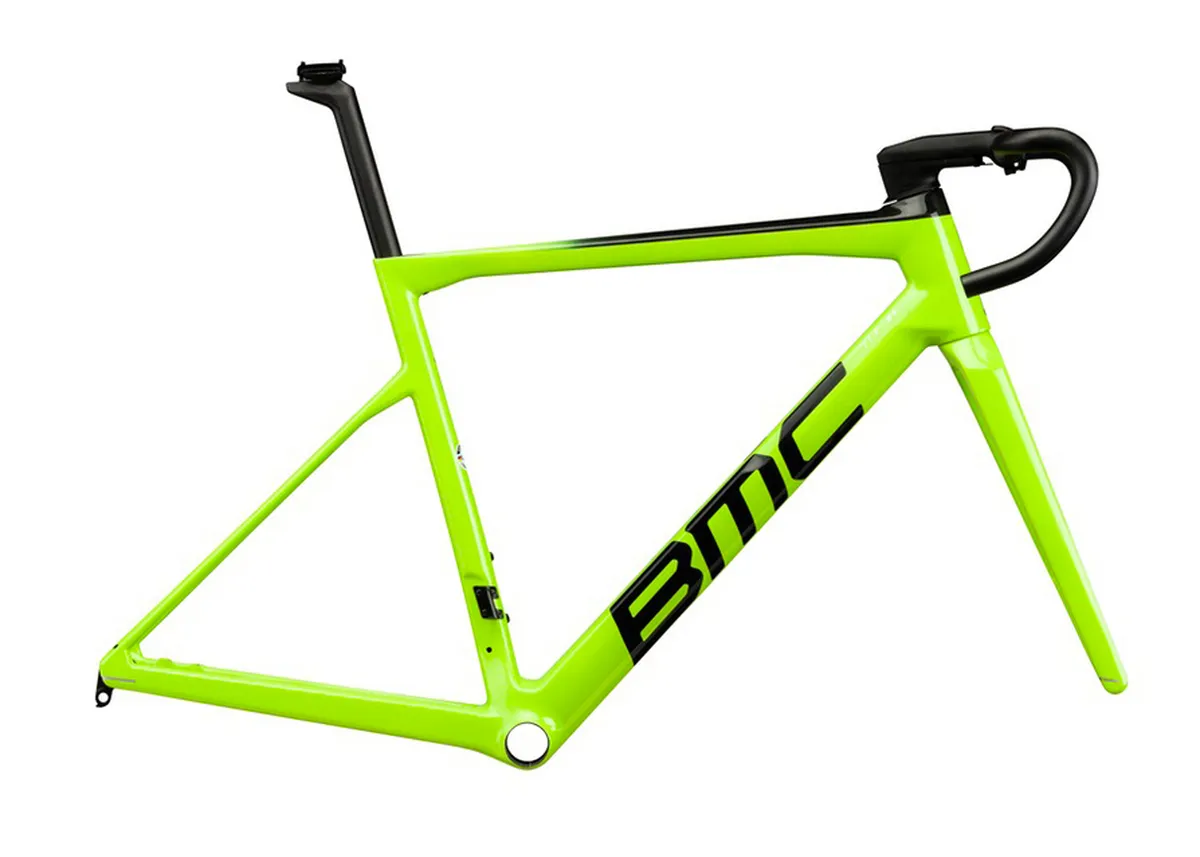
- Price: £TBC / €4,499 / $4,399
- Includes: Frame, fork, ICS 2 stem, BMC RAB 02 bar, seatpost, two aerocore bottle cages, out-front computer mount
- Weight: 2.04kg (54cm claimed weight)
BMC Teammachine SLR One

- Price: £5,000 / €,5599 / $5,499
- Weight: 7.7kg (54cm – claimed weight, including two bottle cages)
- Frame: Carbon with stealth dropouts
- Fork: Carbon with stealth dropouts
- Gears: SRAM Force AXS (48/35, 10-28)
- Brakes: SRAM Force
- Wheels: CRD 351 carbon
- Bar/stem: BMC RAB02 bar, ICS2 stem
- Saddle: Fizik Antares R7
- Seatpost: Teammachine D-shaped carbon
- Tyres: Vittoria Rubino 25mm
- Extras: Out-front computer mount, two Aerocore bottle cages, tubeless valves, integrated computer mount
BMC Teammachine SLR Two
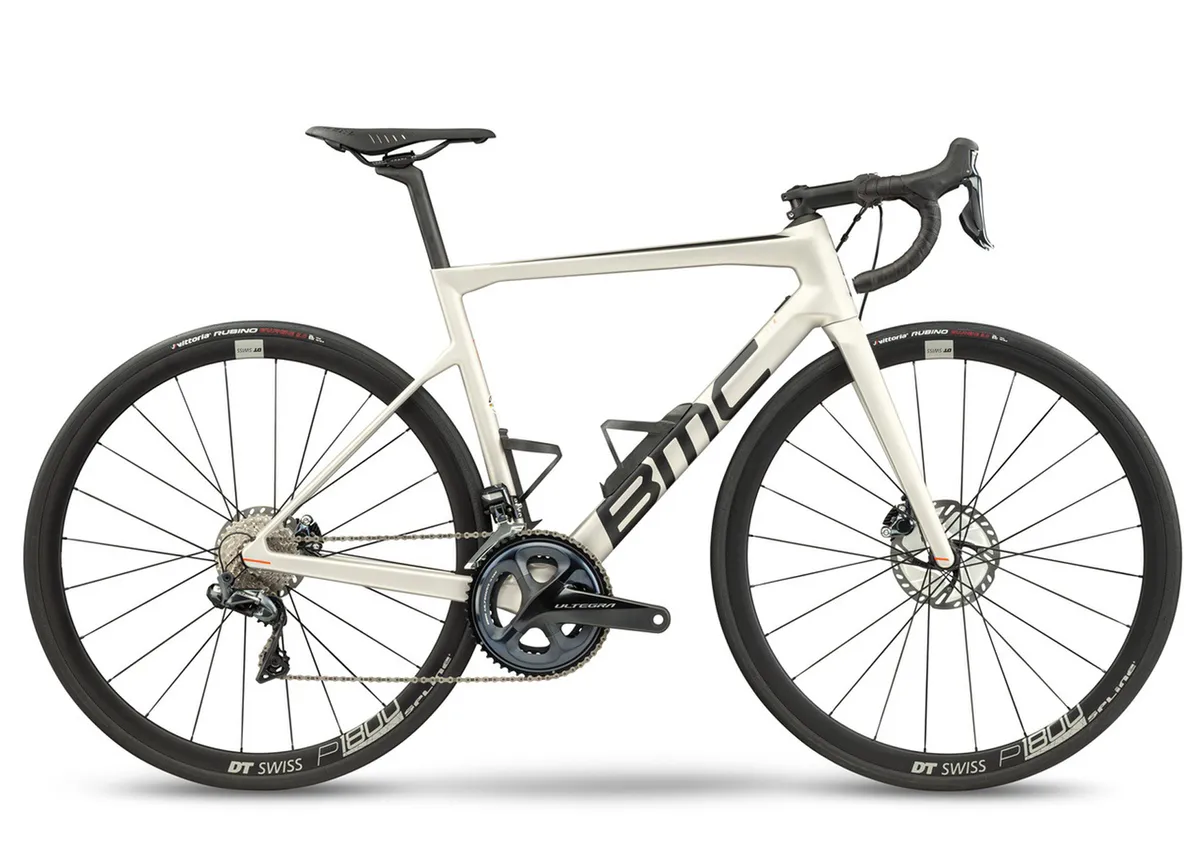
- Price: £4,500 / €4,999 / $4,999
- Weight: 7.7kg (54cm – claimed weight, including two bottle cages)
- Frame: Carbon with stealth dropouts
- Fork: Carbon with stealth dropouts
- Gears: Shimano Ultegra Di2 (52/36, 11-30)
- Brakes: Shimano Ultegra
- Wheels: DT Swiss P1800 db
- Bar/stem: BMC RAB02 bar, RSM01 stem
- Saddle: Fizik Antares R7
- Seatpost: Teammachine D-shaped carbon
- Tyres: Vittoria Rubino 25mm
- Extras: Out-front computer mount, two Aerocore bottle cages, tubeless valves, integrated computer mount
BMC Teammachine SLR Three
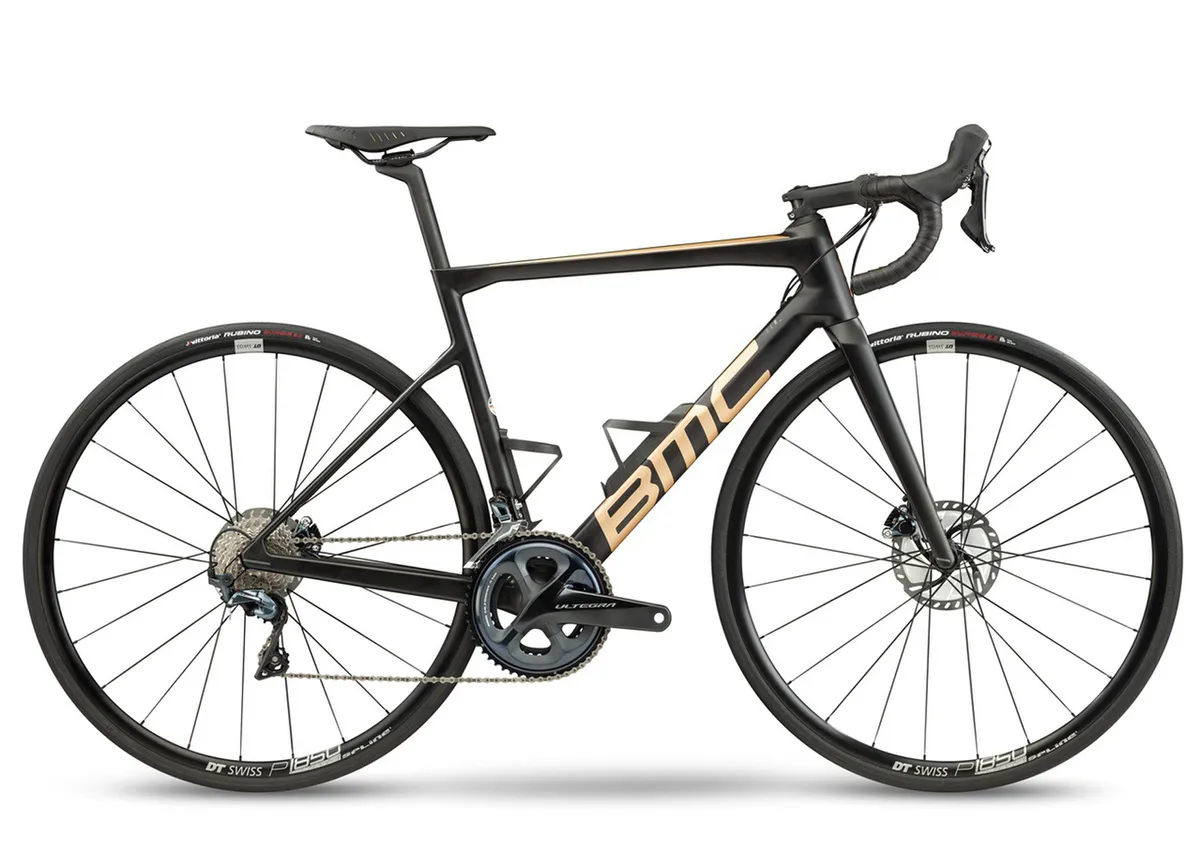
- Price: £3,500 / €3,799 / $3,799
- Weight: 7.79kg (54cm – claimed weight, including two bottle cages)
- Frame: Carbon with stealth dropouts
- Fork: Carbon with stealth dropouts
- Gears: Shimano Ultegra (52/36, 11-30)
- Brakes: Shimano Ultegra
- Wheels: DT Swiss P1850 db spline
- Bar/stem: BMC RAB02 bar, RSM01 stem
- Saddle: Fizik Antares R7
- Seatpost: Teammachine D-shaped carbon
- Tyres: Vittoria Rubino 25mm
- Extras: Out-front computer mount, two Aerocore bottle cages, tubeless valves, integrated computer mount
BMC Teammachine SLR Four

- Price: £2,700 / €2,999 / $2,899
- Weight: 8.12kg (54cm – claimed weight, including two bottle cages)
- Frame: Carbon with stealth dropouts
- Fork: Carbon with stealth dropouts
- Gears: Shimano 105 (52/36, 11-30)
- Brakes: Shimano 105
- Wheels: Shimano RS-170
- Bar/stem: BMC RAB02 bar, RSM01 stem
- Saddle: Fizik Antares R7
- Seatpost: Teammachine D-shaped carbon
- Tyres: Vittoria Rubino 25mm
- Extras: Out-front computer mount, two Aerocore bottle cages, tubeless valves, integrated computer mount
